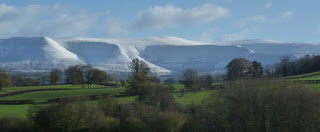It’s a pretty miserable, wet, misty day here in Mid-Wales, the sort that puts many people right off going out to sketch the landscape, but even in winter we can get some fine days when being out with a sketchbook is a real treat. Recently we had a fall of snow and the Black Mountains looked glorious in the late November sunshine as you can see below.
 Now that winter has arrived it’s worth gearing up ready for that day when you wake up and the scenery outside is stunning, and begging to be painted. Preparation in advance is the key: if you have to search for everything the snow may well have melted, the early morning atmosphere dissipated and the best part of the day gone before you are ready for action.
Now that winter has arrived it’s worth gearing up ready for that day when you wake up and the scenery outside is stunning, and begging to be painted. Preparation in advance is the key: if you have to search for everything the snow may well have melted, the early morning atmosphere dissipated and the best part of the day gone before you are ready for action. For sketching if you want to work quickly with minimum fuss a few pencils, watercolour pencils or sticks and a small cartridge sketchbook are all you need, plus your camera. Thin gloves of the Thinsulate sort help you draw in cold conditions, but a flask with a hot drink or soup can be a great morale-booster. Even better while you are sketching is a thermal travel mug which keeps your drink hot for hours – very welcome as you wait for a wash to dry or contemplate how much more of the composition to include. Note how the flask is prominent on the sledge during this sketching break amidst Arctic icebergs! The trouble with ice and snow is that watercolour is the best medium to capture their subtleties, but in temperatures below zero this is not the easiest option……….
For sketching if you want to work quickly with minimum fuss a few pencils, watercolour pencils or sticks and a small cartridge sketchbook are all you need, plus your camera. Thin gloves of the Thinsulate sort help you draw in cold conditions, but a flask with a hot drink or soup can be a great morale-booster. Even better while you are sketching is a thermal travel mug which keeps your drink hot for hours – very welcome as you wait for a wash to dry or contemplate how much more of the composition to include. Note how the flask is prominent on the sledge during this sketching break amidst Arctic icebergs! The trouble with ice and snow is that watercolour is the best medium to capture their subtleties, but in temperatures below zero this is not the easiest option……….
You can get further tips and techniques in my book Winter Landscapes in Watercolour which is available from all good bookshops, or if you would like a signed copy, from my website. At the moment there is a special free offer of a pack of Christmas cards with each copy of the book. Whatever you do don’t miss out on the marvellous opportunities for capturing winter landscapes when the colours, the light and the trees are all so evocative. Just make sure you choose the right day to venture out!





